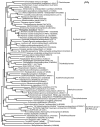Physiological and genomic features of a novel sulfur-oxidizing gammaproteobacterium belonging to a previously uncultivated symbiotic lineage isolated from a hydrothermal vent
- PMID: 25133584
- PMCID: PMC4136832
- DOI: 10.1371/journal.pone.0104959
Physiological and genomic features of a novel sulfur-oxidizing gammaproteobacterium belonging to a previously uncultivated symbiotic lineage isolated from a hydrothermal vent
Abstract
Strain Hiromi 1, a sulfur-oxidizing gammaproteobacterium was isolated from a hydrothermal vent chimney in the Okinawa Trough and represents a novel genus that may include a phylogenetic group found as endosymbionts of deep-sea gastropods. The SSU rRNA gene sequence similarity between strain Hiromi 1 and the gastropod endosymbionts was approximately 97%. The strain was shown to grow both chemolithoautotrophically and chemolithoheterotrophically with an energy metabolism of sulfur oxidation and O2 or nitrate reduction. Under chemolithoheterotrophic growth conditions, the strain utilized organic acids and proteinaceous compounds as the carbon and/or nitrogen sources but not the energy source. Various sugars did not support growth as a sole carbon source. The observation of chemolithoheterotrophy in this strain is in line with metagenomic analyses of endosymbionts suggesting the occurrence of chemolithoheterotrophy in gammaproteobacterial symbionts. Chemolithoheterotrophy and the presence of homologous genes for virulence- and quorum sensing-related functions suggest that the sulfur-oxidizing chomolithotrophic microbes seek animal bodies and microbial biofilm formation to obtain supplemental organic carbons in hydrothermal ecosystems.
Conflict of interest statement
Figures




References
-
- Takai K, Nakagawa S, Reysenbach AL, Hoek J (2006) Microbial ecology of Mid-Ocean Ridges and Back-arc Basins. In: Christie DM, Fisher CR, Lee SM, Givens S, editors.Back-Arc Spreading Systems – Geological, Biological, Chemical, and Physical Interactions.Washington DC, USA: American Geophysical Union. pp. 185–213.
-
- Jørgensen BB, Boetius A (2007) Feast and famine-microbial life in the deep-sea bed. Nat Rev Microbiol 5: 770–781. - PubMed
-
- Nakagawa S, Takai K (2008) Deep-sea vent chemoautotrophs: diversity, biochemistry and ecological significance. FEMS Microbiol Ecol 65: 1–14. - PubMed
-
- Dubilier N, Bergin C, Lott C (2008) Symbiotic diversity in marine animals: the art of harnessing chemosynthesis. Nat Rev Microbiol 6: 725–740. - PubMed
Publication types
MeSH terms
Substances
Associated data
- Actions
- Actions
- Actions
LinkOut - more resources
Full Text Sources
Other Literature Sources
Molecular Biology Databases

